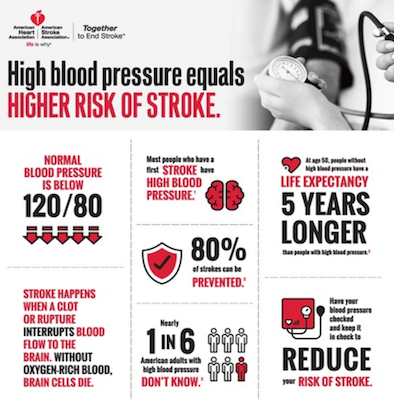Preventing or mitigating high blood pressure is the leading preventative measure for avoiding strokes. | STROKEASSOCIATION.ORG
A new survey from the American Heart Association/ American Stroke Association reports that roughly one in three US adults say they have experienced a symptom consistent with a warning or “mini” stroke.
Yet, only three percent of those encountering the symptoms reported having taken the action recommended by health experts.
These findings were released on May 1, the first day of Stroke Month, an effort to raise awareness about these warnings signs and to emphasize the steps that can be taken to minimize risk. The survey included 2,040 adults nationwide.
Despite warnings signs, only three percent take action
According to the AHA/ ASA, 80 percent of all strokes are preventable, and high blood pressure is the most important controllable risk factor.
Yet, strokes kill 133,000 Americans annually, and are a leading cause of serious, long-term disability. Roughly an equal number of Americans have strokes and heart attacks each year.
Warning or “mini” strokes are termed transient ischemic attacks or TIAs. The difference between a TIA and a stroke is that, in a TIA, the clot blocking blood flow to the brain is transient, or temporary. About 15 percent of strokes, however, are preceded by a TIA, and someone experiencing a TIA has a much higher risk of a stroke within 90 days than other people.
The American Stroke Association urges adults to learn the acronym FAST to remember the warning signs: Face drooping, Arm weakness, Speech difficulty means it’s Time to call 911. Other symptoms include sudden confusion, trouble speaking, or understanding; sudden numbness or weakness in the face, arm, or leg, especially on one side of the body; sudden trouble seeing in one or both eyes; sudden trouble walking, dizziness, loss of balance, or coordination; and sudden severe headache with no known cause.
According to Dr. Mitch Elkind, chair of the American Stroke Association, “Officially, about five million Americans, or 2.3 percent, have had a self-reported, physician-diagnosed TIA, but as this survey suggests, we suspect the true prevalence is higher because many people who experience symptoms consistent with a TIA fail to report it.”
He added, “Ignoring any stroke sign could be a deadly mistake. Only a formal medical diagnosis with brain imaging can determine whether you’re having a TIA or a stroke. If you or someone you know experiences a stroke warning sign that comes on suddenly — whether it goes away or not — call 911 right away to improve chances of an accurate diagnosis, treatment, and recovery.”
Among the survey’s other finding was that respondents who had experienced trouble walking, dizziness, loss of balance or coordination, or a numbness or weakness in the face, arm, or leg were the most likely among all adults experiencing warning signs to call 911 — but even there, only five percent took action. The most common symptoms reported among those who experienced warning signs were sudden severe headaches (20 percent) and sudden trouble walking, dizziness, loss of balance or coordination (14 percent).
Significantly, 77 percent of respondents were unfamiliar with the term transient ischemic attack. While 55 percent of survey participants said they would phone 911 if TIA symptoms emerged, only three percent had done so.
If a diagnosis shows that a clot is blocking blood flow to the brain, a clot-busting drug might be used to address that. Alternatively, a stent retriever might be used to remove the clot, which can help reduce long-term disability.
Those diagnosed with a stroke or a TIA will be advised to make lifestyle changes, may be prescribed medication to manage known risk factors, and might be put on an antiplatelet like aspirin to inhibit clotting.
One in six Americans with high blood pressure don’t know it. Normal levels are below 120/ 80. At age 50, adults without high blood pressure have an average life expectancy five years longer than those with high blood pressure.
For more information about strokes, its risks, and how to mitigate them, visit strokeassociation.org.






































